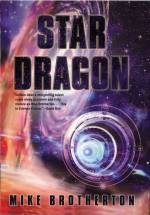Search
Science in My Science Fiction: Come to the Dark Side
September 16th, 2007
This originally ran at www.sfnovelists.com on September 14. Putting it here for my own personal archive. Enjoy!
I’m a scientist, a professional astronomer, who writes hard science fiction. I wish it weren’t called “hard†because that makes it sound difficult, when it’s more fun and understandable than most people think. The “hard†really refers to the notion that results in the physical sciences are reliable, that they are calculated, quantitative, not about how difficult it is. Truth be told, the “soft†sciences like biology and sociology are the hard ones, topics so complicated that we can’t usually provide reliable explanations for observed phenomenon. It’s easier to determine if a particular asteroid is going to hit our planet, and when, than if a dingo is going to wander along and take your baby.
Now, I like hip urban fantasies as much as the next guy, but science is the driving force behind our modern technological civilization (you’re not reading this in goat entrails, are you?). I like science in my science fiction. Call me old school. There’s a lot of really cool things out there in our universe that are real, yet more bizarre than anything you’re going to see on Buffy or Battlestar Galactica. Let’s take the case of dark matter, which features prominently in my forthcoming book, Spider Star.
Dark matter. It’s a cool-sounding phrase, but what the heck is it exactly? The short answer is that it’s matter that doesn’t emit light that helps solve all sorts of astronomical problems, and we really don’t have a clue about what it is. Not exactly, anyway. But we know that most of it is like nothing anyone has ever seen before.
The story of dark matter starts back in the 1930s with Fritz Zwicky, a brilliant but difficult Caltech astronomer, who was studying galaxy clustering. Galaxies group together, apparently under the force of gravity, and between Newton and Einstein, humans seem to have a pretty good idea of how gravity works. There’s a very general relationship between gravity, speed, and size, that governs everything from the orbit of the moon around Earth to how galaxies fly around through the dark voids of the universe. What Zwicky soon realized was this: galaxies in the Coma Cluster were flying around so quickly that the gravity associated with the galaxies he could see with his telescopes was by far insufficient to keep the whole mess from flying apart. So he proposed that there was matter there, dark matter, that he wasn’t seeing. The concept of dark matter, along with many of Zwicky’s other ground-breaking ideas, might have been explored more seriously and more quickly if he didn’t have the bad habit of calling everyone “bastards.â€
In the 1960s, a much more personable young astronomer named Vera Rubin started examining galaxies themselves in more details. Using telescopes armed with spectrographs, which split light into its constituent colors, she could measure Doppler shifts indicative of the velocities of stars moving in the galaxies. She looked at spiral galaxies like our own Milky Way, especially ones that appeared to be close to edge on, and saw that one side moves toward us while the other side moves away, just what is expected if these whirlpools in the sky are rotating. More careful examination revealed the same problem that Zwicky had noted nearly 40 years earlier: the gravity associated with the visible stars was insufficient to explain why such rapidly rotating galaxies didn’t fly apart.
Astronomers started proposing different candidates for this mysterious dark matter. One idea is that the dark matter is made up of weakly interacting massive particles, AKA “WIMPs.†These WIMPs could be things we know about like the nearly massless neutrinos, or more theoretical particles like axions, that rarely touch normal matter in any significant way, but do have gravity. Another idea, almost in opposition, is that the dark matter is made up of massive compact halo objects, or “MACHOs.†A MACHO might be something like a neutron star or black hole, very massive but also very dark. Gravitational lensing, a confirmed prediction of Einstein’s Theory of Relativity in which massive objects bend and magnify light, has provided observational evidence that MACHOs exist, but the data also indicate that MACHOs aren’t numerous enough to account for but a fraction of the dark matter.
Current observations of gravitational lensing by galaxy clusters indicates cluster masses right in line with what the irascible Zwicky estimated so long ago. Last year there was a new result out from the Chandra X-ray Observatory that provides direct proof for dark matter based on observations of “the bullet cluster,†which is a collision of two galaxy clusters. The majority of normal, baryonic, matter is in the form of very hot gas in clusters. This hot gas emits X-rays that we can see and trace. In the case of the bullet cluster, drag during the collision has impeded the motion of the hot gas. Not the majority of the matter — dark, non-baryonic matter. The weird stuff. That has moved on through just as expected without slowing. And we can trace it by the gravitational lensing of background galaxies. Thus the center of mass of the two clusters has become separated from the center of mass of the hot X-ray gas, which constitutes the bulk of the normal matter. You can’t explain away this result by invoking modified Newtonian dynamics, as some try to do for galactic rotation curves and other indirect evidence of dark matter.
Many of other lines of evidence also support the existence of large amounts of dark matter. The most compelling these days come from cosmology, involving several arcane types of analysis such as the cosmic abundances of the light elements like hydrogen and helium and the pattern of hot and cold patches in the microwave background radiation. Even though we don’t know just want the dark matter is, we think we know how much there is and what it isn’t made of.
While some small portion of the dark matter is made up of MACHOs, and other things like brown dwarfs, rogue planets, and the like, the majority of it is not made up of conventional, baryonic matter, that consists of things made of stuff in those entries on the periodic table. This so-called non-baryonic matter is not made of protons, neutrons, and electrons. It’s made up of stuff we’ve only got the barest inkling about. A fraction is neutrinos, one not-so-massive WIMP. The rest might be any one, or several, of a number of candidates.
One way people commonly hunt for neutrinos and other dark matter candidates is to sit at the bottom of deep mines, far away from sunlight, cosmic rays, and any normal form of radiation from space that might disturb an experiment, and to search for things capable of penetrating through miles of earth. One famous experiment in neutrino detection took place at the Homestake Mine near Lead, South Dakota, for example. The problem, of course, is that anything that can penetrate miles of normal matter is also capable of penetrating experimental detectors. The Homestake Mine experiment made use of some 500 tons of dry cleaning fluid, searching for the rare product of a neutrino converting a chloride atom into a radioactive isotope of argon. Similarly, advocates of different dark matter WIMP candidates predict what rare interactions these particles might have with normal matter, and search for those products in a controlled fashion. One such experiment is the Cryogenic Dark Matter Search taking place in the Soudan Mine in Minnesota. Some claims of dark matter particle detections have been made, but so far none are verified.
The topic of dark matter comes up in conversation in physics departments around the country, in a few supercool coffee houses here and there, and in science fiction book clubs, but it’s talk about a whole bunch of nothing that no one can even touch. Lots of people have put forth their theories about what it is, and who knows? One of people may be right, even if he’s an obnoxious guy who calls everyone else bastards.
You can follow any responses to this entry through the RSS 2.0 feed. You can skip to the end and leave a response. Pinging is currently not allowed.

